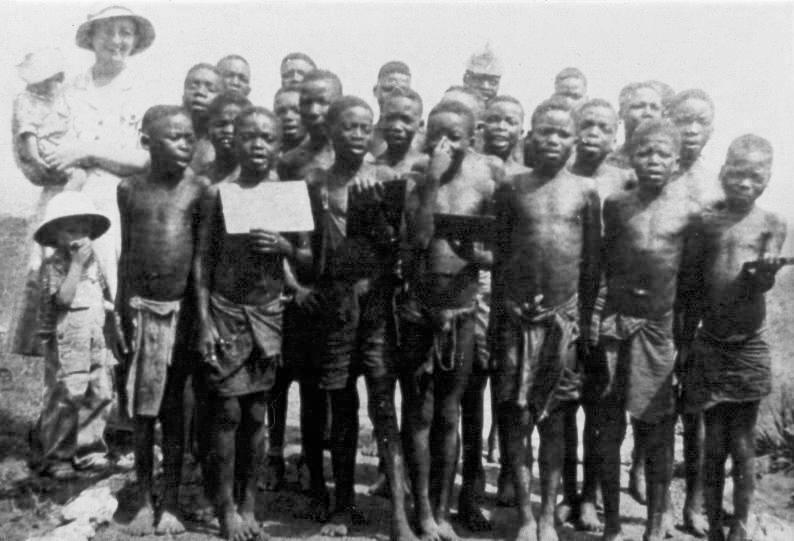
Belgian Congo: Belgian Colonial Education (1908-61)

Figure 1.--Most schools in the Belgian Colony were operated by Catholic missionaries, but there were also Protestant missiionries asctive. This photo was taken at the Baptist mission located in Vanga during the 1940s. It shows the pastor's wife with two of her children and a group of boys attending the missionary school. The older son is wearing a colonial pith helmet. One of the African boys wears wehat look like bib-shorts. The other boys are wearing a cloth wrapped around the waist. Probably that was required by the missionaries at school. In equatorial Africa traditionally, because iof the climate, boys commonly didn't wear any clothing before puberty.
|
|
The Belgian Government after revelations about terrible astrocities perpetrated by authorities in the Congo Free State formally took over administration of the colony (1908). A extensive educational sysem was founded, mostly at the primary level. The Government had little to do with the schools. They were mostly run by missionary groups, especially the Catholic missiionaries. We think that the Belgian Government help finance the Catholic missionary system, but we do not have details at this time. In the period after World War II, about 10 percent of Congolese children were attending primary school, compared to just 3 percent in neighboring French Equatorial Africa. This was one of the largest missionary school efforts outside of China. The rate of primary school attendance in the Congo was suprisingly one of the highest in Africa, One source claims tht it reached 56 percent (1959). This high attendance rate, however, is misleading. Most of the children in primary schools only attednded for the first 2 years. Less than 10 percent of the children completed the 6-year primary program--but this was relatively high by African standards. Only a few Congolese children advanced to the secondary level, let along to university studies. Belgian officials finally opened two universities (mid-1950s). At the time of independence, however, almost no Congolese students had university degrees. The colony was as a result almost totally unprepared for independence.
Belgian Government Comtrol
The Belgian Government after revelations about terrible astrocities perpetrated by authorities in the Congo Free State formally took over administration of the colony (1908).
New School System
A extensive educational sysem was founded, mostly at the primary level. The Government had little to do with the schools. They were mostly run by missionary groups, especially the Catholic missiionaries. We think that the Belgian Government help finance the Catholic missionary system, but we do not have details at this time.
Ideology
The text books prepared by the Belgian authorities were designed to promote the colonial ideology. At the heart of this was the legitimacy of Belgian colonial rule. The text books were used to create respect for Belgian authority. The symbols of colonial authority appeared in the texts used for the children. They presented the traditional beliefs and lifestyle of the Congolese before the arrival of the Belgians as primitive if not barbaric. In contrast, the Belgian institutions and values were presentedcas both modern and good. The Belgian institutions (justice system, the military, taxes and corvées, religion, healthcare, industrialisation, and school education) are all presented to the children.
The Congolese wre incouraged to immitate the Belgians and and acquire the skills needed for modern life. Historical treated depicted the Belgins and Europeans in general as the ideal if not heroiic, mythical beings. And the Congolese were depicted as just the opposite, according to one source 'In the hands of the Devil.". A few text books provided a more critical look ar Belgian colonial socity. [Vinck]
We have only limited chronolological information on Congolese colonia schools at this time. We have some information on the schols after World War II. In the period after World War II, about 10 percent of Congolese children were attending primary school, compared to just 3 percent in neighboring French Equatorial Africa. This was one of the largest missionary school efforts outside of China. The rate of primary school attendance in the Congo was suprisingly one of the highest in Africa, One source claims that it reached 56 percent (1959). This high attendance rate, however, is misleading. Most of the children in primary schools only attednded for the first 2 years. Less than 10 percent of the children completed the 6-year primary program--but this was relatively high by African standards at the time. Only a few Congolese children advanced to the secondary level, let along to university studies. Belgian officials finally opened two universities (mid-1950s). At the time of independence, however, almost no Congolese students had university degrees. The colony was as a result almost totally unprepared for independence.
Sources
Vinck, Honoré. "Ideology in the Schoolbooks in the Belgian Congo".
HBC

Related Chronolgy Pages in the Boys' Historical Web Site
[The 1880s]
[The 1890s]
[The 1900s]
[The 1910s]
[The 1920s]
[The 1930s]
[The 1940s]
[The 1930s]
[The 1940s]
[The 1950s]
[The 1960s]
[The 1970s]
[The 1980s]
Related Style Pages in the Boys' Historical Web Site
[Long pants suits]
[Knicker suits]
[Short pants suits]
[Socks]
[Eton suits]
[Jacket and trousers]
[Blazer]
[School sandals]
[School smocks]
[Sailor suits]
[Pinafores]
[Long stockings]
Navigate the Boys' Historical Clothing Web Page
[Return to the Main Democratic Republic of the Congo Belgian School page]
[Return to the Main Democratic Republic of the Congo School page]
[Return to the Main Democratic Republic of the Congo page]
[Return to the Main African school uniform country page]
[Introduction]
[Activities]
[Biographies]
[Chronology]
[Clothing styles]
[Countries]
[Bibliographies]
[Contributions]
[FAQs]
[Glossary]
[Images]
[Links]
[Registration]
[Tools]
[Boys' Clothing Home]
Created: 6:20 AM 11/28/2010
Last updated: 10:44 PM 4/28/2012




